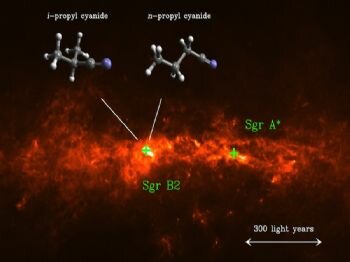
Newfound Molecule in Space Dust Offers Clues to Life's Origins

Complex carbon-bearing molecules detected in interstellar space suggest key ingredients for life on Earth could have alien origins.
Newfound Molecule in Space Dust Offers Clues to Life's Origins
The discovery of a strangely branched organic molecule in the depths of interstellar space has capped a decades-long search for the carbon-bearing stuff.
The molecule in question — iso-propyl cyanide (i-C3H7CN) — was spotted in Sagittarius B2, a huge star-making cloud of gas and dust near the center of the Milky Way, about 27,000 light-years from the sun. The discovery suggests that some of the key ingredients for life on Earth could have originated in interstellar space.
A specific molecule emits light at a particular wavelength and in a telltale pattern, or spectrum, which scientists can detect using radio telescopes. For this study, astronomers used the enormous Atacama Large Millimeter/submillimeter Array (ALMA) telescope in the Chilean desert, which went online last year and combines the power of 66 radio antennas. [5 Bold Claims of Alien Life]
Iso-propyl cyanide joins a long list of molecules detected in interstellar space. But what makes this discovery significant is the structure of iso-propyl cyanide. All other organic molecules that have been detected in space so far (including normal-propyl cyanide, the sister of i-C3H7CN) are made of a straight chain with a carbon backbone. Iso-propyl cyanide, however, has a "branched" structure. This same type of branched structure is a key characteristic of amino acids.
"Amino acids are the building blocks of proteins, which are important ingredients of life on Earth," the study's lead author, Arnaud Belloche, of the Max Planck Institute for Radio Astronomy, told Space.com in an email. "We are interested in the origin of amino acids in general and their distribution in our galaxy."
The central region of the Milky Way can be seen above the antennas of the ALMA observatory in Chile.
Credit: Y. Beletsky (LCO)/ESOView full size image
Scientists have previously found amino acids in meteorites that fell to Earth, and the composition of these chemicals suggested they had an interstellar origin. The researchers in this new study did not find amino acids, but their discovery adds an "additional piece of evidence that the amino acids found in meteorites could have been formed in the interstellar medium," Belloche wrote.
"The detection of a molecule with a branched carbon backbone in interstellar space, in a region where stars are being formed, is interesting because it shows that interstellar chemistry is indeed capable of producing molecules with such a complex, branched structure," Belloche added.
It was first suggested in the 1980s that branched molecules could form on the surface of dust grains in interstellar space. But this is the first time such compounds have been detected. What's more, iso-propyl cyanide seemed to be plentiful — it was almost half as abundant of its more common sister variant in Sagittarius B2, the study found. This means that branched molecules could actually be quite ordinary in interstellar space, the researchers said.
The research is detailed in the Sept. 26 edition of the journal Science.
...
Source : space.com
Comments
Related Posts
- Omics Explorer 3.1 for Mac
- Total Partners with SGI to Upgrade its Pangea Supercomputer
- Aurora-viewers Worldwide Compare Sightings, Provide Real-time Alerts
- Simulating Biofilm Mechanical Behavior Aids Blood Clotting Studies
- Photoacoustic Method allows Rapid Imaging of Living Brain Functions
Recent Posts
- How to add new words to iOS dictionary
- Touch ID patents reveal how Apple uses 'Secure Enclave' in iPhone 5s' A7 chip for fingerprint sensor
- WiFi 's data-free risks for terrorists and criminals
- Mobile phone on planes
- To extend the battery life on your iPhone, iPad and Android
- Google Glass Development Kit (GDK)
- Back Up data on Android Smartphone
- What is Google Glass?
- WhatsApp iOS 7 update of fancy design on German YouTube channel
- Jury's decision 290 million dollar fine about the patent litigation between Samsung and Apple
- A New Application; SNAPCHAT is Wanted to Buy BY GOOGLE AND FACEBOOK
- Apple Buys Action Sensor Maker PrimeSense
- November 25th International Day for the Elimination of Violence Against Women
- Potato Power Could Light the World But How??
- Could be doomsday for Giants
- About Us
- Authors
- Contact
- Privacy Policy
- RSS
- | @ Women Citizen
